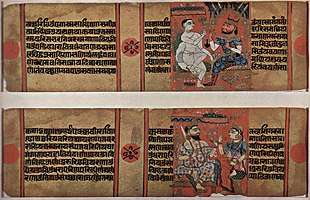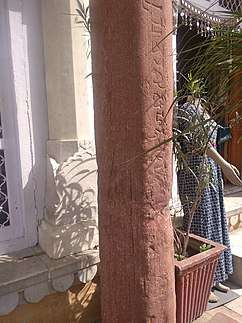Vikram Samvat
Vikram Samvat (IAST: Vikrama Samvat; abbreviated V.S. (or VS) and B.S. (or BS); ![]()
History
A number of ancient and medieval inscriptions used the Vikram Samvat. Although it was reportedly named after the legendary king Vikramaditya, the term "Vikrama Samvat" does not appear in the historical record before the 9th century; the same calendar system is found with other names, such as Krita and Malava.[3] In colonial scholarship, the era was believed to be based on the commemoration of King Vikramaditya expelling the Sakas from Ujjain. However, later epigraphical evidence and scholarship suggest that this theory has no historical basis. During the 9th century, epigraphical artwork began using Vikram Samvat (suggesting that the Hindu calendar era in use became popular as Vikram Samvat); Buddhist and Jain epigraphy continued to use an era based on the Buddha or the Mahavira.[4]
Vikramaditya legend

According to popular tradition, King Vikramaditya of Ujjain established the Vikrama Samvat era after defeating the Śakas.
Kalakacharya Kathanaka (An account of the monk Kalakacharya), by the Jain sage Mahesarasuri, gives the following account: Gandharvasena, the then-powerful king of Ujjain, abducted a nun called Sarasvati, who was the sister of the monk. The enraged monk sought the help of the Śaka ruler King Sahi in Sistan. Despite heavy odds but aided by miracles, the Śaka king defeated Gandharvasena and made him a captive. Sarasvati was repatriated, although Gandharvasena himself was forgiven. The defeated king retired to the forest, where he was killed by a tiger. His son, Vikramaditya, being brought up in the forest, had to rule from Pratishthana (modern Paithan in Maharashtra). Later on, Vikramaditya invaded Ujjain and drove away from the Śakas. To commemorate this event, he started a new era called the "Vikrama era". The Ujjain calendar started around 58–56 BCE, and the subsequent Shaka-era calendar was started in 78 CE at Pratishthana.
Historical origins
The association of the era beginning in 57 BCE with Vikramaditya is not found in any source before the 9th century CE; earlier sources call the era "Kṛṭa" (343 and 371 CE), "Kritaa" (404), "the era of the Malava tribe" (424), or simply "Samvat".[5][6] The earliest known inscription which calls the era "Vikrama" is from 842. This inscription, from the Chauhana ruler Chandamahasena, was found at Dholpur and is dated "Vikrama Samvat 898, Vaishakha Shukla 2, Chanda" (16 April 842). The earliest known inscription which associates the era with a king called Vikramaditya is dated 971, and the earliest literary work connecting the era to Vikramaditya is Subhashita-Ratna-Sandoha (993-994) by the Jain author Amitagati.[6]
A number of authors believe that the Vikram Samvat was not started by Vikramaditya, who might be a legendary king or a title adopted by a later king who renamed the era after himself. V. A. Smith and D. R. Bhandarkar believed that Chandragupta II adopted the title of Vikramaditya, and changed the era's name to "Vikrama Samvat". According to Rudolf Hoernlé, the king responsible for this change was Yashodharman. Hoernlé believed that he conquered Kashmir and is the "Harsha Vikramaditya" mentioned in Kalhana's Rajatarangini.[6]
Some earlier scholars believed that the Vikraa Samvat corresponded to the Azes era of the Indo-Scythian (Śaka) king King Azes. This was disputed by Robert Bracey after the discovery of an inscription of Vijayamitra, which is dated in two eras.[7] The theory was discredited by Falk and Bennett, who place the inception of the Azes era in 47–46 BCE.[8]
Culture
In Gujarat, the day after Diwali is celebrated as the first day of the Vikram Samvat calendar (the first day of the month of Kartik).[9]
Popularity
The Vikram Samvat has been used by Hindus and Sikhs.[10] One of several regional Hindu calendars in use on the Indian subcontinent, it is based on twelve synodic lunar months and 365 solar days.[10][11] The lunar year begins with the new moon of the month of Chaitra.[12] This day, known as Chaitra Sukhladi, is a restricted holiday in India.[13]
The calendar remains in use by Hindus in Nepal and north, west and central India.[3] In south India and portions of east and west India (such as Assam, West Bengal and Gujarat), the Indian national calendar is widely used.[14]
With the arrival of Islamic rule, the Hijri calendar became the official calendar of sultanates and the Mughal Empire. During British colonial rule of the Indian subcontinent, the Gregorian calendar was adopted and is commonly used in urban areas of India.[15] The predominantly-Muslim countries of Pakistan and Bangladesh have used the Islamic calendar since 1947, but older texts included the Vikram Samvat and Gregorian calendars. In 2003, the India-based Sikh Shiromani Gurdwara Parbandhak Committee controversially adopted the Nanakshahi calendar.[10] The Vikram Samvat is the official calendar of Nepal.[16]
Calendar system
The Vikram Samvat is similar in design to the Gregorian calendar, but differs from the Hebrew calendar.[10] Unlike the Gregorian calendar, which adds days to the lunar month to adjust for the mismatch between twelve lunar cycles (354 lunar days)[17] and nearly 365 solar days, the Vikram Samvat and Hebrew calendars maintain the integrity of the lunar month; an extra month 'appears', on a strict scientific basis, roughly once every three years (or 7 times in a 19-year cycle, to be more exact) to ensure that festivals and crop-related rituals fall in the appropriate season. The extra month appears in Chinese and Jewish calendars as well; in India it is called adhik maas. The Vikram Samvat is one of the lunisolar calendars developed by ancient human cultures.[10][11] Early Buddhist communities in India adopted the ancient Hindu calendar, followed by the Vikram Samvat and local Buddhist calendars. Buddhist festivals are still scheduled according to a lunar system.[18]
The Vikram Samvat has two systems. It began in 56 BCE in the southern Hindu calendar system (amaanta) and 57–56 BCE in the northern system (purnimaanta). The Shukla Paksha, when most festivals occur, coincides in both systems.[14][5] The lunisolar Vikram Samvat calendar is 56.7 years ahead of the solar Gregorian calendar; the year 2076 VS began in 2019 CE, and ended in 2020 CE.
The Rana dynasty of Nepal made the Vikram Samvat the official Hindu calendar in 1901, which began as Samvat 1958.[19] The new year in Nepal begins with the first day of the month of Baishakh, which usually falls around 13–15 April in the Gregorian calendar. The first day of the new year is celebrated in Bisket Jatra, an annual carnival in Bhaktapur. In 2007, Nepal Sambat was recognized as the national calendar.
In India, the reformulated Saka calendar is officially used (except for computing dates of the traditional festivals). In the Hindi version of the preamble of the constitution of India, the date of its adoption (26 November 1949) is presented in Vikram Samvat as Margsheersh Shukla Saptami Samvat 2006. A call has been made for the Vikram Samvat to replace the Saka calendar as India's official calendar.[20]
Divisions of a year
The Vikram Samvat uses lunar months and solar sidereal years. Because 12 months do not match a sidereal year, correctional months (adhika māsa) are added or (occasionally) subtracted (kshaya masa). A lunar year consists of 12 months, and each month has two fortnights. The lunar days are called tithis. Each month has 30 tithis, which vary in length from 20 to 27 hours. The waxing phase, beginning with the day after the new moon (amavasya), is called gaura or shukla paksha (the bright or auspicious fortnight). The waning phase is called krishna or vadhya paksha (the dark fortnight, considered inauspicious).[21]
Lunar metrics
- A tithi is the time it takes for the longitudinal angle between the Moon and the Sun to increase by 12°.[22] Tithis begin at various times of the day, and vary in duration.
- A paksha (or pakṣa) is a lunar fortnight and consists of 15 tithis.
- A māsa, or lunar month (about 29.5 days), is divided into two paksas.
- A ritu (season) is two māsas.[22]
- An ayana is three ritus.
- A year is two ayanas.[22]
Month
Vikra Samvat is approximately 57 years ahead of Gregorian Calendar. Currently 2077 is running on Vikram Sambat Whereas In Gregorian Calendar 2020 is running. The months in the Vikram Samvat,[23] with their roughly corresponding Gregorian months, are:
References
- Masatoshi Iguchi (2015). Java Essay: The History and Culture of a Southern Country. TPL. p. 135. ISBN 978-1-78462-885-7.
- Edward Simpson (2007). Muslim Society and the Western Indian Ocean: The Seafarers of Kachchh. Routledge. pp. 113–114. ISBN 978-1-134-18484-2.
- Richard Salomon (1998). Indian Epigraphy: A Guide to the Study of Inscriptions in Sanskrit, Prakrit, and the Other Indo-Aryan Languages. Oxford University Press. pp. 182–183. ISBN 978-0-19-509984-3.
- Richard Salomon (1998). Indian Epigraphy: A Guide to the Study of Inscriptions in Sanskrit, Prakrit, and the Other Indo-Aryan Languages. Oxford University Press. pp. 182–183, 194–195. ISBN 978-0-19-509984-3.
- Ashvini Agrawal (1989). Rise and Fall of the Imperial Guptas. Motilal Banarsidass. pp. 174–175. ISBN 978-81-208-0592-7.
- M. Srinivasachariar (1974). History of Classical Sanskrit Literature. Motilal Banarsidass. pp. 94–111. ISBN 9788120802841.
- Alf Hiltebeitel (2011). Reading the Fifth Veda: Studies on the Mahābhārata. BRILL. p. 103. ISBN 978-90-04-18566-1.
- Falk and Bennett (2009), pp. 197-215.
- "Gujarat CM to exchange Diwali-New Year greetings with people". 19 October 2014. Retrieved 24 October 2014.
- Eleanor Nesbitt (2016). Sikhism: a Very Short Introduction. Oxford University Press. pp. 122–123. ISBN 978-0-19-874557-0.
- Christopher John Fuller (2004). The Camphor Flame: Popular Hinduism and Society in India. Princeton University Press. pp. 109–110. ISBN 978-0-69112-04-85.
- Davivajña, Rāma (1996) Muhurtacintāmaṇi. Sagar Publications
- India.gov.in
- Richard Salomon (1398). Indian Epigraphy: A Guide to the Study of Inscriptions in Sanskrit, Prakrit, and the other Indo-Aryan Languages. Oxford University Press. pp. 181–183. ISBN 978-0-19-535666-3.
- Tim Harper; Sunil Amrith (2014). Sites of Asian Interaction: Ideas, Networks and Mobility. Cambridge University Press. pp. 56–57. ISBN 978-1-316-09306-1.
- Bal Gopal Shrestha (2012). The Sacred Town of Sankhu: The Anthropology of Newar Ritual, Religion and Society in Nepal. Cambridge Scholars Publishing. pp. 13–14. ISBN 978-1-4438-3825-2.
- Orazio Marucchi (2011). Christian Epigraphy: An Elementary Treatise with a Collection of Ancient Christian Inscriptions Mainly of Roman Origin. Cambridge University Press. p. 289. ISBN 978-0-521-23594-5., Text: "...the lunar year consists of 354 days..."
- Anita Ganeri (2003). Buddhist Festivals Through the Year. BRB. pp. 11–12. ISBN 978-1-58340-375-4.
- Encyclopedia of New Year's Holidays Worldwide, William D. Crump, Publisher McFarland, 2014 p.38
- "Vikram Samvat should be declared national calendar". The Free Press Journal. 15 February 2012. Archived from the original on 26 April 2014. Retrieved 28 March 2012.
- "What Is the Hindu Calendar System?". Learn Religions. Archived from the original on 6 May 2019. Retrieved 15 September 2019.
- Burgess, Ebenezer Translation of the Sûrya-Siddhânta: A text-book of Hindu astronomy, with notes and an appendix originally published: Journal of the American Oriental Society, vol. 6, (1860), pp. 141–498, Chapter 14, Verse 12
- Chatterjee, SK (1990). Indian Calendric System. Government of India. p. 17.
Further reading
| Wikisource has the text of the 1911 Encyclopædia Britannica article Vikramaditya. |
- Harry Falk and Chris Bennett (2009). "Macedonian Intercalary Months and the Era of Azes." Acta Orientalia 70, pp. 197–215.
- "The Dynastic Art of the Kushan", John Rosenfield.
- . New International Encyclopedia. 1905.
External links
- Kyoto University Gregorian – Saka – Vikrami Calendar Converter Tool, M. YANO and M. FUSHIMI

